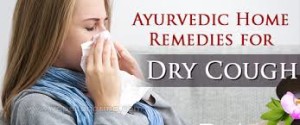There are many useful remedies for cough in Ayurveda. However, the Ayurvedic physicians prize the Malabar Nut (Botanical name is Justicia adhatoda) very much and call it ‘BAIDYAMATA’ meaning ‘mother of all physicians.’ There is a Sanskrit hymn in praise of this remedy which says that, as long as Vasaka will remain, patients suffering from spitting of blood, phthisis and common cough and cold need not despair. Ayurvedic physicians even proclaim that no death can take place from cough from any kind if Vasaka can play its role and be used judiciously to heal the patient.
The Ayurvedic view on cough.
Ayurveda has a very interesting approach to cough. Ayurveda says cough may be a symptomatic manifestation of a swelling of the uvula, accumulation of wax in the ear, constipation or worm infestation. Allopathic physicians recognize that roundworm infestation can cause eosinophilia which is turn may present itself as cough. Keeping in line with its philosophy, Ayurveda classifies cough into three varieties.
1) Cough due to vata imbalance increases at night, persists continuously, is generally dry and may be accompanied by chest pain. They recommend an oil massage over the chest followed by hot water fomentation to provide relief. Jeshtamadh or Talisadichurna with honey can be licked as and when there is a severe bout of cough.
2) Cough due to pitta imbalance, is continuous, is accompanied by yellow, mucoid expectoration. A bitter taste persists in the mouth and there are sour eructations. The juice of adulsa leaves mixed with honey is probably the best treatment for this. A paste made with half a teaspoon of sitopaladichurna and one teaspoon of honey and one-teaspoon ghee makes a good medication to lick when the cough is severe.
3) In the kapha variety, there is heaviness in the chest accompanied by headache. Copious amounts of mucous expectoration occur. The saliva is thick and the mucous is difficult to expel. Ideal remedies include chewing roasted behead (Terminalia bellerica) or sucking a paste of equal quantities of pippali and soonth with honey.
The Malabar Nut is the king of all ayurvedic remedies.
The plant, known, as the, ‘Malabar Nut’ is a small shrub found all over India. The Botanical name of this plant is ‘Justicia adhatoda.’ The bark, leaves, flowers and roots are used extensively in Ayurvedic medicine. It is also commonly called as ‘Vasaka.’
Medicinal uses:
Charaka used it spitting of blood. Sushruta found it an excellent remedy in tuberculosis, respiratory troubles and jaundice. Bavaprakasha found it useful in fevers associated with biliousness and respiratory troubles. Charakadatta found it excellent in slow fevers and leprosy. Bangasena found it useful in piles. In short, all major Ayurvedic books uniformly extol the virtues of Vasaka.
Homoeopathic physicians find this remedy useful hoarseness of the voice and rattling cough, sneezing and whenever copious yellow mucous is expectorated from the chest.
Allopathic research has revealed that it contains fat, resins, a bitter alkaloid, vasicine, an organic acid, adhatodic acid, sugar gum and salts. Allopathic research has also revealed that Vasaka has medicinal properties and is useful in rheumatism, constipation, asthma, chronic bronchitis and other chest affections.
Conclusion:
Today, there is a sharp increase in respiratory disorders due to pollution. We are encountering antibiotic resistant bacteria. There has also been a sharp increase in Community Acquired Pneumonias and Viral lung disorders. There is a tremendous resurgence of Tuberculosis.
At such a time, more research should be done on herbs like Vasaka and our rapidly declining Bio-diversity. Our ancient traditions should be researched and preserved.




